Plant viruses
Plant virology is a fascinating field that unravels the complex interactions between viruses and their plant hosts. These microscopic invaders, though incredibly small, have profound effects on plants, from altering their growth and development to impacting agricultural productivity on a global scale. The journey of plant viruses begins with their entry into host cells—a process that involves breaching the plant’s protective barriers through wounds or vectors like insects.
Understanding how do plant viruses enter and infect host cells, replicate, and spread is key to decoding their behavior and finding ways to mitigate their impact. This blog explores the history of plant virology, the structural diversity of plant viruses, and the sophisticated mechanisms they use to invade and colonize their hosts. Whether you’re a curious plant enthusiast, a biology student, or simply intrigued by the unseen world of plant-pathogen interactions, this guide will provide an in-depth overview of the captivating world of plant virology.
A Brief History of Plant Virology
The study of plant viruses dates back centuries, with some of the earliest records highlighting the impact of viral diseases on agriculture and horticulture. Here are a few key milestones:
- 752 AD: The first recorded disease caused by a geminivirus, a family of single-stranded DNA viruses that continue to plague crops today.
- 1637: The peak of “Tulipomania,” a period in the Dutch Golden Age when tulip bulbs infected with the Tulip breaking virus became highly sought after for their unique, colorful patterns. This virus-induced beauty sparked one of the first economic bubbles in history.
These historical events underscore the profound influence of plant viruses on human society, from agriculture to economics.
What is a Virus?
A virus is fundamentally an infectious particle composed of nucleic acid—either DNA or RNA—encased within a protective protein shell known as a capsid. This simple yet effective structure allows viruses to invade and hijack the cellular machinery of their hosts, including plants.
Plant viruses exhibit diverse shapes and structural configurations, each uniquely adapted to facilitate infection:
- Filamentous: Long, slender, thread-like structures.
- Complex: Irregularly shaped viruses with additional structural components.
- Icosahedral: Symmetrical, spherical shapes composed of 20 triangular faces.
- Enveloped: Viruses enclosed within a lipid membrane derived from the host cell.
The capsid, constructed from smaller protein subunits called capsomers, plays a crucial role in shielding the viral genome and enabling its delivery into host cells. This structural diversity among plant viruses reflects their remarkable adaptability and efficiency in colonizing a wide range of plant hosts.
Classification of Plant Viruses
Plant viruses are classified primarily based on the type of nucleic acid they contain—either DNA or RNA—and the structural organization of their genome. These characteristics determine their replication strategies, modes of transmission, and interactions with their plant hosts. Below is an overview of the major groups:
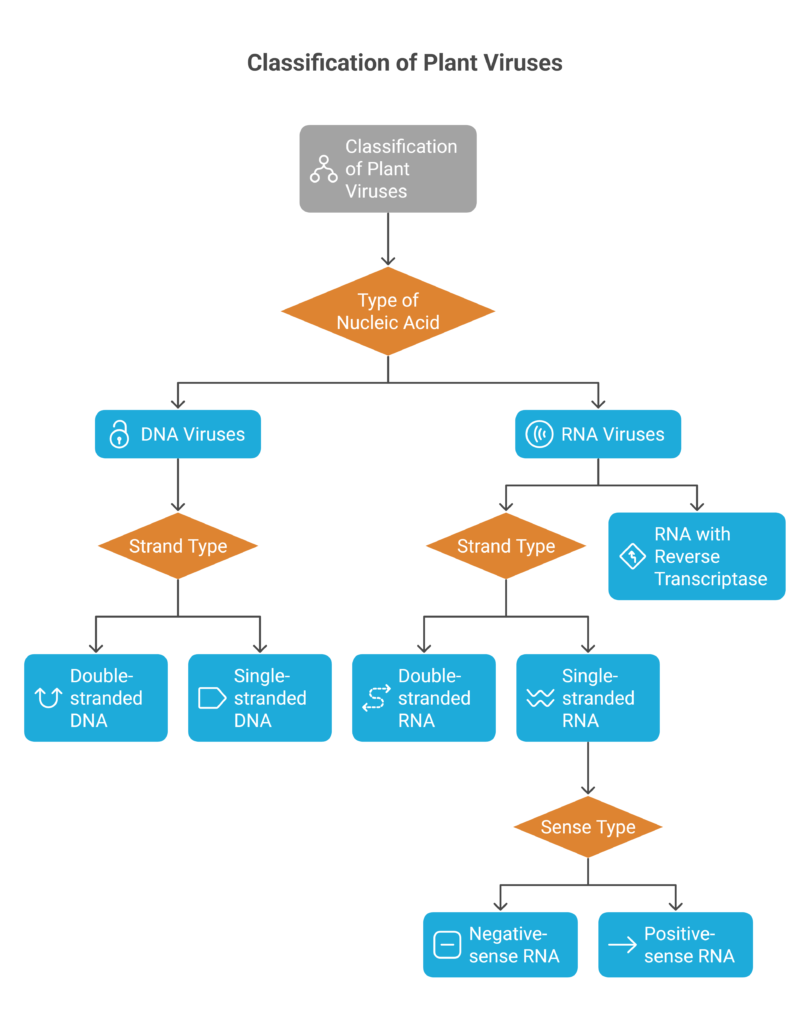
1. DNA Viruses
DNA viruses infect plants using either double-stranded or single-stranded DNA as their genetic material.
A). Double-stranded DNA (dsDNA)
- Viruses in the Caulimoviridae family fall into this category.
- They replicate through reverse transcription, a process where DNA is transcribed into RNA and then reverse-transcribed back into DNA.
- Example: Cauliflower mosaic virus (CaMV).
B). Single-stranded DNA (ssDNA)
- Viruses in the Geminiviridae and Nanoviridae families belong here.
- These viruses are often transmitted by insect vectors, such as whiteflies and leafhoppers.
- Examples: Maize streak virus (Geminiviridae) and Banana bunchy top virus (Nanoviridae).
2. RNA Viruses
RNA viruses are more diverse and widespread in plants, with their genomes classified as double-stranded or single-stranded RNA.
A). Double-stranded RNA (dsRNA)
- Includes the Reoviridae and Partitiviridae families.
- These viruses often infect plants via insect vectors and can cause systemic infections.
- Example: Rice ragged stunt virus (Reoviridae).
B). Single-stranded RNA (ssRNA)
Divided into three main categories based on the sense of their RNA strand:
i. Negative-sense RNA
- Found in families like Bunyaviridae and Rhabdoviridae.
- These viruses must first convert their RNA into a positive-sense strand to produce proteins.
- Example: Rice stripe virus (Bunyaviridae).
ii. Positive-sense RNA
- Includes families such as Potyviridae, Closteroviridae, and Tombusviridae.
- Positive-sense RNA acts directly as messenger RNA (mRNA) for protein synthesis.
- Examples: Tobacco mosaic virus (TMV, Potyviridae) and Citrus tristeza virus (Closteroviridae).
iii. RNA with Reverse Transcriptase
- Found in families like Pseudoviridae and Metaviridae.
- These viruses replicate via an RNA intermediate that undergoes reverse transcription.
- Example: Tobacco retrovirus (Metaviridae).
Diversity in Genome Structure and Strategies
Each viral family is distinct in its genome organization, replication mechanisms, and methods of transmission, reflecting the incredible adaptability of plant viruses. For instance:
- Some viruses use insect vectors for efficient plant-to-plant spread.
- Others manipulate the plant’s molecular machinery to enhance their replication or movement.
The Viral Replication Cycle
The replication cycle of plant viruses is a carefully orchestrated process involving distinct stages that allow the virus to invade, multiply, and spread throughout the host plant. This cycle can be broadly divided into three key phases: Entry, Genome Expression and Replication, and Movement and Transmission. Each phase is essential for the successful colonization of the plant host and ensures the virus’s survival and propagation.
A). Entry and Uncoating
The first stage of the viral life cycle begins with the virus entering the plant cell. Since plants have rigid cell walls, viruses cannot penetrate on their own and rely on external factors for entry. These factors include:
- Mechanical Damage: Physical wounds caused by environmental factors like wind, hail, or handling.
- Insect Vectors: Many plant viruses depend on vectors like aphids, whiteflies, or beetles to breach the plant’s protective layers.
- Other Pathways: Nematodes, fungi, or parasitic plants can also act as carriers.
Once inside the plant cell, the virus sheds its protective protein coat, a process called uncoating, to release its nucleic acid (RNA or DNA). This uncoating exposes the viral genome, which is now ready to hijack the plant’s cellular machinery for replication.
B). Genome Expression and Replication
After uncoating, the viral genome takes over the plant cell’s molecular machinery. This stage involves two critical processes:
i. Genome Expression
The viral genetic material directs the host cell to produce viral proteins necessary for replication. These proteins include:
- Replicase enzymes for genome copying.
- Structural proteins for assembling new viral particles.
- Movement proteins to assist in spreading the infection to neighboring cells.
ii. Replication
- Using the host cell’s resources, the virus multiplies its genetic material.
- The replication process differs depending on the type of nucleic acid:
- RNA Viruses: Positive-sense RNA can act directly as mRNA, while negative-sense RNA requires conversion to a positive strand before translation.
- DNA Viruses: Often replicate in the nucleus, where the host’s DNA machinery is located.
The plant cell, now overwhelmed by viral activity, prioritizes viral protein and genome production over its normal functions, leading to symptoms like stunted growth, chlorosis, or wilting.
C). Movement and Transmission
Once the virus has been replicated, it must spread to other cells and tissues to establish a systemic infection. This phase involves two distinct modes of movement:
i. Local Movement Through Plasmodesmata
- Plasmodesmata are microscopic channels that connect adjacent plant cells, allowing the transfer of substances, including viral particles or nucleic acids.
- Movement proteins encoded by the virus modify the plasmodesmata to facilitate the passage of viral components into neighboring cells.
ii. Systemic Transmission via Phloem
- After infecting a few cells locally, the virus enters the plant’s vascular system, specifically the phloem, which transports nutrients and other substances.
- This systemic movement allows the virus to travel long distances and infect different parts of the plant, including leaves, stems, and roots.
How Plant Viruses Infect and Spread
Plant viruses are microscopic agents of disease that rely entirely on their hosts for survival and reproduction. The infection and spread of plant viruses involve a series of well-coordinated steps that enable the virus to invade a plant, multiply, and disseminate throughout its tissues. This process can be broken down into four key stages: Initial Entry Through Wounded Cells, Uncoating and Replication, Cell-to-Cell Movement, and Systemic Spread.
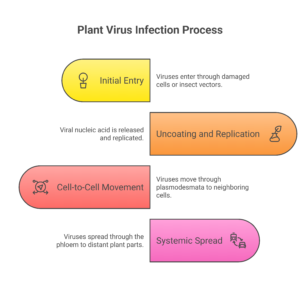
A). Initial Entry Through Wounded Cells
Unlike animal viruses, plant viruses cannot penetrate the rigid cell walls of plants on their own. Instead, they require entry points created by external factors, such as:
- Mechanical Damage: Physical injuries caused by environmental stressors like wind, hail, or handling during cultivation.
- Insect Vectors: Many plant viruses rely on insects, such as aphids, whiteflies, and thrips, to pierce the plant’s cuticle and epidermis during feeding. These vectors act as carriers, transferring viral particles between plants.
- Other Pathways: Nematodes, fungi, or parasitic plants like Cuscuta (dodder) can also facilitate viral entry by bridging the gap between plants.
Once the virus breaches the protective layers of the plant, it enters the cytoplasm of the host cell, marking the beginning of the infection process.
B). Uncoating and Replication
Upon entering the host cell, the virus sheds its protective protein coat in a process known as uncoating, releasing its nucleic acid (RNA or DNA) into the cytoplasm. This nucleic acid contains the genetic instructions necessary for viral replication.
The viral genome takes control of the host cell’s machinery to produce:
- New Viral Genomes: Copies of the original viral genetic material.
- Viral Proteins: Structural proteins for assembling new virus particles and movement proteins to assist in spreading the infection.
This replication phase leads to an accumulation of viral particles within the infected cell, overwhelming the host’s normal cellular processes and often causing visible symptoms such as leaf discoloration, stunted growth, or deformation.
C). Cell-to-Cell Movement
To expand the infection, the virus needs to move beyond the initially infected cell. This is achieved through:
- Plasmodesmata: Tiny, microscopic channels that connect adjacent plant cells.
- Movement Proteins: Viral proteins modify plasmodesmata, widening them to allow the passage of viral particles or nucleic acids into neighboring cells.
This localized spread through plasmodesmata ensures that the infection progresses from cell to cell, gradually affecting the surrounding tissues.
D). Systemic Spread
After infecting a cluster of cells, the virus transitions to systemic infection by entering the plant’s vascular system, specifically the phloem. The phloem serves as the plant’s nutrient transport network, enabling the virus to travel long distances and infect different parts of the plant, such as:
- Leaves.
- Stems.
- Roots.
This systemic spread allows the virus to colonize the entire plant, leading to widespread disease symptoms. The dual mechanism of local movement through plasmodesmata and long-distance transport via the phloem ensures the virus’s efficient dissemination within its host.
Role of Plasmodesmata and Phloem
- Plasmodesmata: Facilitates the virus’s local spread by connecting neighboring cells.
- Phloem: Acts as a highway for systemic transport, allowing the virus to infect distant tissues and organs.
This dual strategy of movement maximizes the virus’s ability to infect and propagate within its host, ensuring its survival and continued spread.
Transmission of Plant Viruses
Plant viruses rely on various transmission methods to spread between plants, as they cannot move on their own. Plant viruses spread through a combination of mechanical processes, vegetative propagation, infected reproductive structures, and living vectors. Effective management requires monitoring of all these pathways to prevent virus outbreaks and protect crop health. These methods can be broadly classified into mechanical means, vegetative propagation, seed and pollen transmission, and through biological vectors. Here is a detailed explanation of each method:
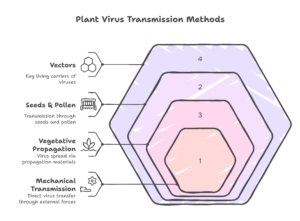
A). Mechanical Transmission
Mechanical transmission occurs when plant viruses are physically transferred from an infected plant to a healthy one through external forces. This is a non-biological method where the virus enters the plant through wounds.
Causes of Mechanical Transmission
- Human Activities: Virus particles can spread through contaminated tools during pruning, handling infected plants, or other agricultural practices.
- Grafting: Joining tissues of a healthy plant with an infected one allows direct virus transfer.
- Environmental Factors: Strong winds, rain splashes, or accidental plant injuries can create entry points for viruses.
Examples: Tobacco mosaic virus (TMV) is a well-known virus transmitted through mechanical means.
B). Vegetative Propagation
This method involves the transmission of viruses through plant parts used for reproduction. If propagation material is infected, all new plants derived from it will carry the virus.
Sources of Infection
- Cuttings: Infected stems or branches used for propagation.
- Bulbs and Corms: Underground storage organs can harbor viruses.
- Rhizomes and Tubers: Viruses present in these structures spread to new plants during vegetative reproduction.
Examples: Potato viruses (e.g., Potato Virus Y) are commonly spread through infected tubers.
C). Seeds and Pollen Transmission
Certain plant viruses can infect the reproductive structures, allowing them to be passed to the next generation through seeds or pollen.
- Seed Transmission: Viruses within infected seeds spread to seedlings, perpetuating the infection cycle.
- Pollen Transmission: Infected pollen can transmit viruses to flowers during fertilization, infecting the resulting seeds and tissues.
Examples:
- Cucumber mosaic virus (CMV) can spread through infected seeds.
- Tobacco vein banding virus (TVBV) is transmitted via pollen.
D). Vectors (Biological Carriers)
Vectors are living organisms that carry and transfer plant viruses between hosts. Viruses often rely on vectors to spread efficiently across plant populations. Key vectors include:
- Arthropods (Insects and Mites)
- Insect Vectors: Insects such as aphids, whiteflies, thrips, and leafhoppers are the most common virus vectors. They acquire viruses while feeding on infected plants and transmit them to healthy ones.
- Transmission Types
- Non-persistent (Stylet-borne): Virus remains in the insect’s mouthparts temporarily (e.g., cucumber mosaic virus by aphids).
- Persistent (Circulative and Propagative): Virus circulates within the insect’s body or replicates inside the vector (e.g., Tomato yellow leaf curl virus by whiteflies).
- Nematodes (Microscopic Soil-Dwelling Worms)
Certain soil-borne viruses are transmitted by nematodes that feed on plant roots. These viruses can persist in the soil for long periods.
Examples: Tobacco rattle virus (TRV) is spread by Trichodorus nematodes.
- Fungi and Fungal-Like Organisms
Some viruses are transmitted through zoospores (motile spores) of soil-borne fungi. These fungi infect the roots and allow virus entry.
Examples: Beet necrotic yellow vein virus (BNYVV) is transmitted by Polymyxa betae.
- Parasitic Plants
Parasitic plants like Cuscuta (dodder) act as natural bridges, transferring viruses between plants as they penetrate and connect vascular tissues.
Example: Alfalfa mosaic virus (AMV) can be transmitted through dodder connections.
Key Takeaways
- Plant viruses are diverse in structure and behavior, with unique replication and transmission strategies.
- Historical events like Tulipomania highlight the cultural and economic impact of plant viruses.
- Understanding viral infection mechanisms is crucial for developing strategies to protect crops and ensure food security.
Plant virology is not just a scientific discipline; it’s a window into the delicate balance between plants, viruses, and the environment. By studying these microscopic invaders, we can better appreciate the complexity of life and develop innovative solutions to combat plant diseases.
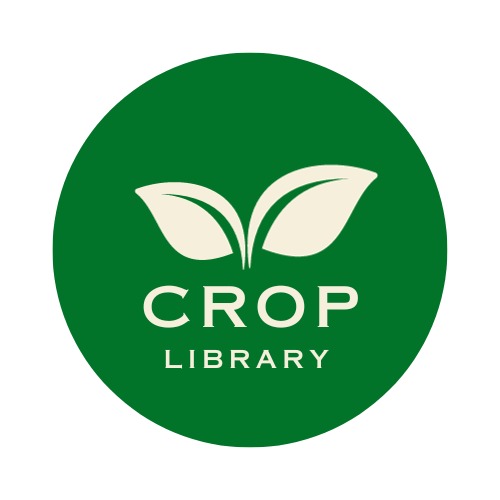
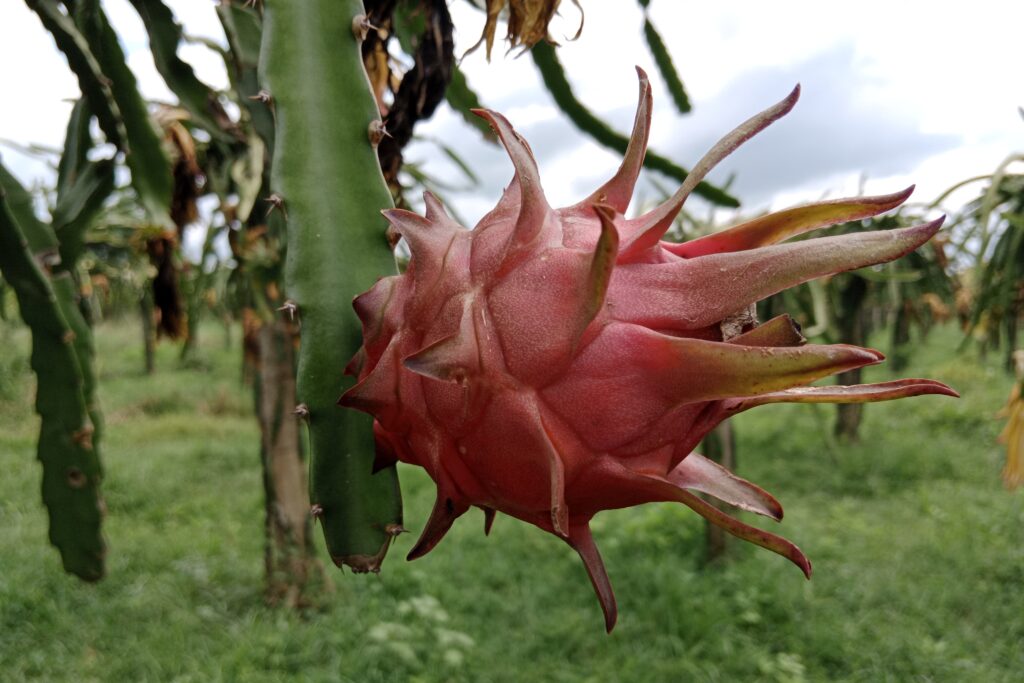
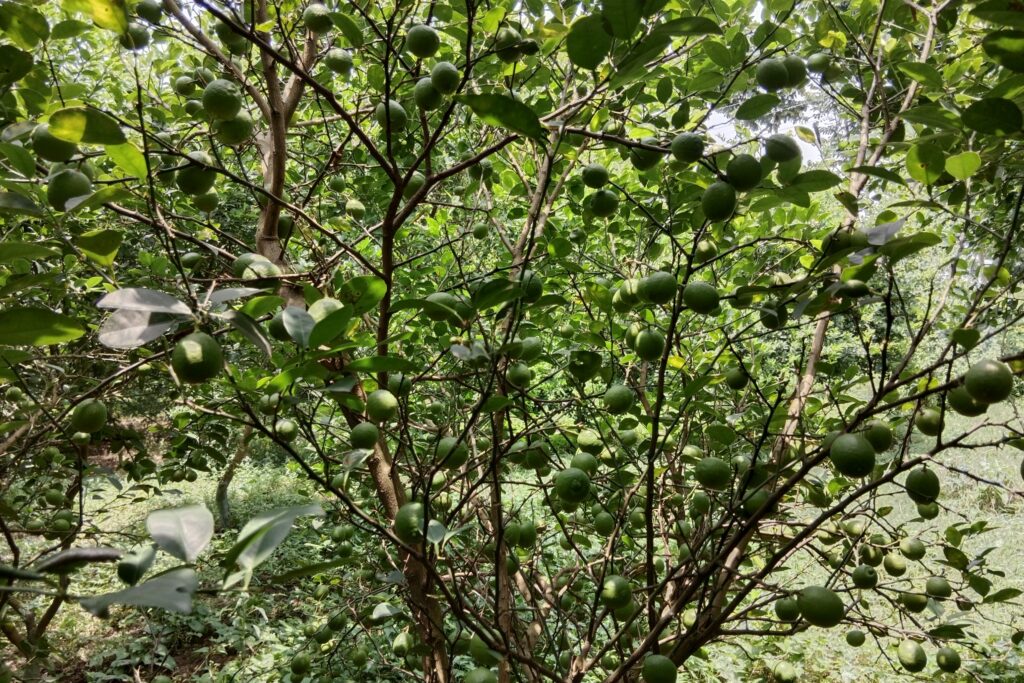
Pingback: Understanding Plant Resistance Mechanisms -